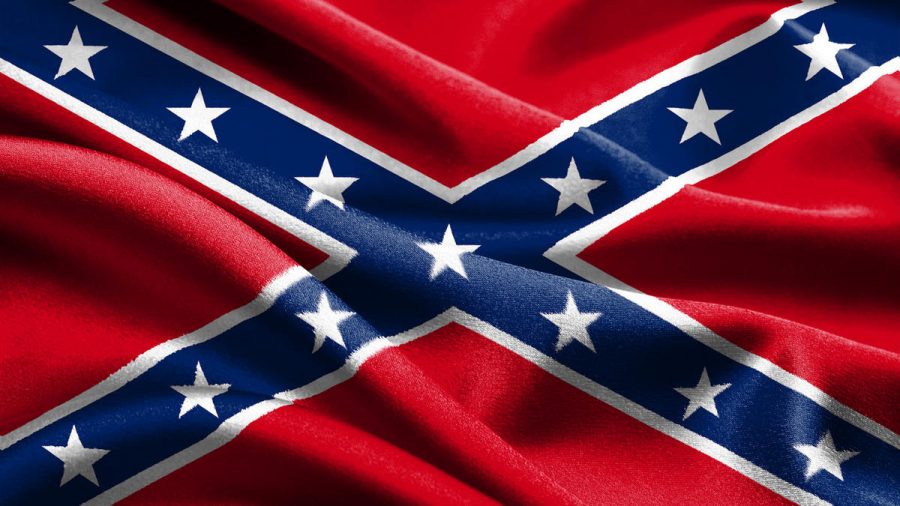Confederate Monuments: Symbols of Racism
These memorials glorify the South’s history of hate and oppression towards African Americans
November 20, 2018
The general crept out of his tent in the early morning and gazed over his starved exhausted campsite. He let out a prolonged sorrowful sigh, realizing he was faced with only one option. After retreating into his quarters, he sluggishly shuffled to far corner of his quarters and squatted down. He gathered a single piece of paper and his calligraphy pen, and for the next hour, meticulous scribbles filled the general’s ears.
A Union soldier sauntered to his general’s quarters, lowered his head and peered in, golden wrinkly paper in hand. He was beckoned in and quickly greeted the commander. After being dismissed, he briskly strutted out of the tent. General Ulysses S. Grant gazed over the document and paused. He looked around his tent in utter disbelief. He hastily read over it again before it flew out of his hands and drifted to the ground. His head fell in his palms as a wave of relief encompassed him. He strolled out of his tent and gathered his soldiers.
Grant famously said, “The war is over. The Rebels are our countrymen again.”
In 1869, Robert E. Lee was questioned about setting up Confederate memorials in Gettysburg, Pennsylvania. He stated, “I think it wiser not to keep open the sores of war but to follow the examples of those nations who endeavored to obliterate the marks of civil strife, to commit to oblivion the feelings engendered.”
Lee objected the institution of Confederate memorials, but they stand regardless. These monuments are the spark for intense debate between Americans. They believe either the statues preserve the South’s history or represent the oppression of African Americans.
“Sad to see the history and culture of our great country being ripped apart with the removal of our beautiful statues and monuments,” President Donald Trump tweeted in 2017.
Many supporters of the statues’ conservation defend them using this logic. However, this is contradictory. The South has been an oppressive place for African Americans, from decades of slavery to countless acts of violence in the 1960’s. The notion that the Confederate flag, a symbol for a traitorous country that supported slavery, does not represent racism or oppression is ridiculous. That flag represents a time when a group of people were subordinate to whites for many years. A definition change of hatred or racism would only prove this argument logical.
The times most of these statues erected further proves they stand for oppression and racism.
“Eventually they started to build Confederate monuments,” history professor at the University of North Carolina, Greensboro Mark Elliott said, per History.com. “The vast majority of them were built between the 1890s and 1950s, which matches up exactly with the era of Jim Crow segregation.”

Supporters believe these aren’t racist symbols, but they were constructed at times when white southerners were asserting their dominance through Jim Crow laws. If they were built to remember Confederate leaders, then they would have been made following the Civil War, not three decades later.
“All of those monuments were there to teach values to people,” Elliott said in the article. “That’s why they put them in the city squares. That’s why they put them in front of state buildings.”
Statues commemorate people and events, not history. The Statue of Liberty represents America’s freedom for all. It doesn’t serve as a lesson on our country’s history of immigration. The Lincoln Memorial in Washington D.C. is constructed to symbolize how Americans look up to a leader who broke chains of millions. These are set up in places where many will see: immigrants coming into the United States and citizens visiting the nation’s capital. If Americans wanted to learn and preserve history, they would read books or watch documentaries. Statues glorify events and leaders, they do not teach us about history.
The Confederate Memorial Carving, started in the 1950’s and finished in 1972, depicts General “Stonewall” Jackson, Lee and Confederation President Jefferson Davis. According to “Waiting for Crazy Horse” writer for the New York Times Lawrence Downes said, “Looking up at the mountain in the golden light of late afternoon, it was hard not to be impressed, even moved, by this effort to honor the memory of a people this country once tried to mightily erase.”
Memorials on mountains and large statues of people are created to idolize figures. It is blatant the largest high relief sculpture in the world commemorates generals that stood for treachery and animosity.
The fact Confederate memorials are in city squares and in huge mountains sends the message Americans idolize traitors and racist slave owners, whether they believe it or not.
Confederate leaders, like Jackson, Lee and Davis, and American presidents, such as Thomas Jefferson and George Washington, all owned or supported slavery, yet these statues hold a different connotation.
Mount Rushmore idolizes Abraham Lincoln, Franklin Roosevelt, Jefferson and Washington for their battles against slavery, guidance through the Great Depression and the founding of our country, respectively. There are many ways to interpret monuments like these. However, Confederate leaders represent one idea: a fight to conserve slavery.
These generals betrayed the United States and fought for the preservation of slavery. No matter which way monument supporters try to look at it, they did not found the United States, nor did they guide it through perilous times. In fact, they severely harmed the country and headed an enemy of its citizens.
It is not intelligent to forget history to idolize prominent figures, but these generals did nothing noble for the United States.
These monuments brazenly commemorate racist traitors, thus showing this country supports ideals such as theirs. Obviously, racism is deep in the country, however, we should not strive to represent ourselves in such a way.
If supporters want to remember their history, such as Trump, then these statues can be moved to museums, where people can view these generals in a historical context. They can read literature or watch documentaries to explore their past. They certainly do not need statues to remember their ancestors.
The removal of these statues is imperative to help to lessen racist messages in this country, which all citizens should support. If not, they continue to add to the deep rooted acrimony in the United States.







